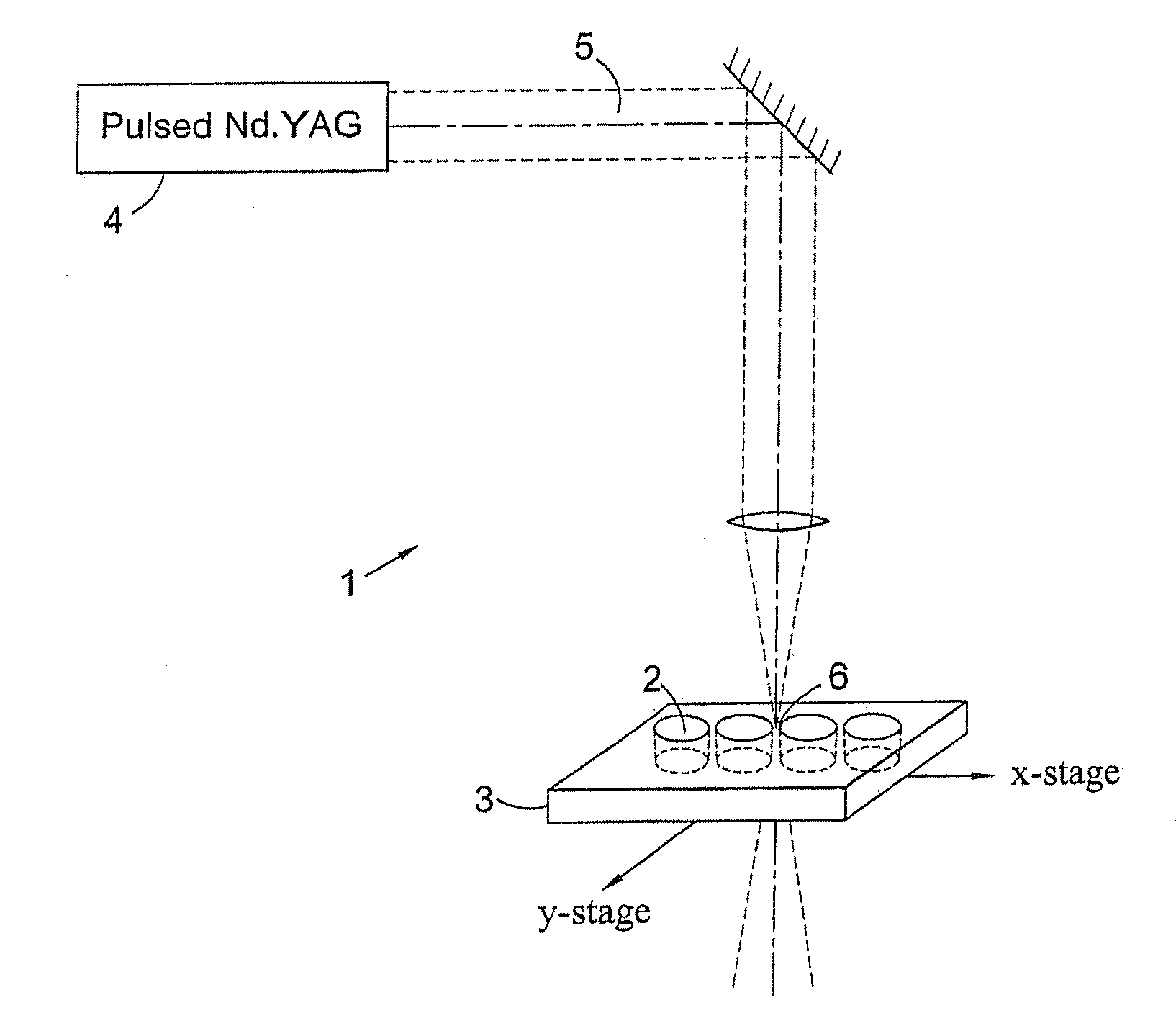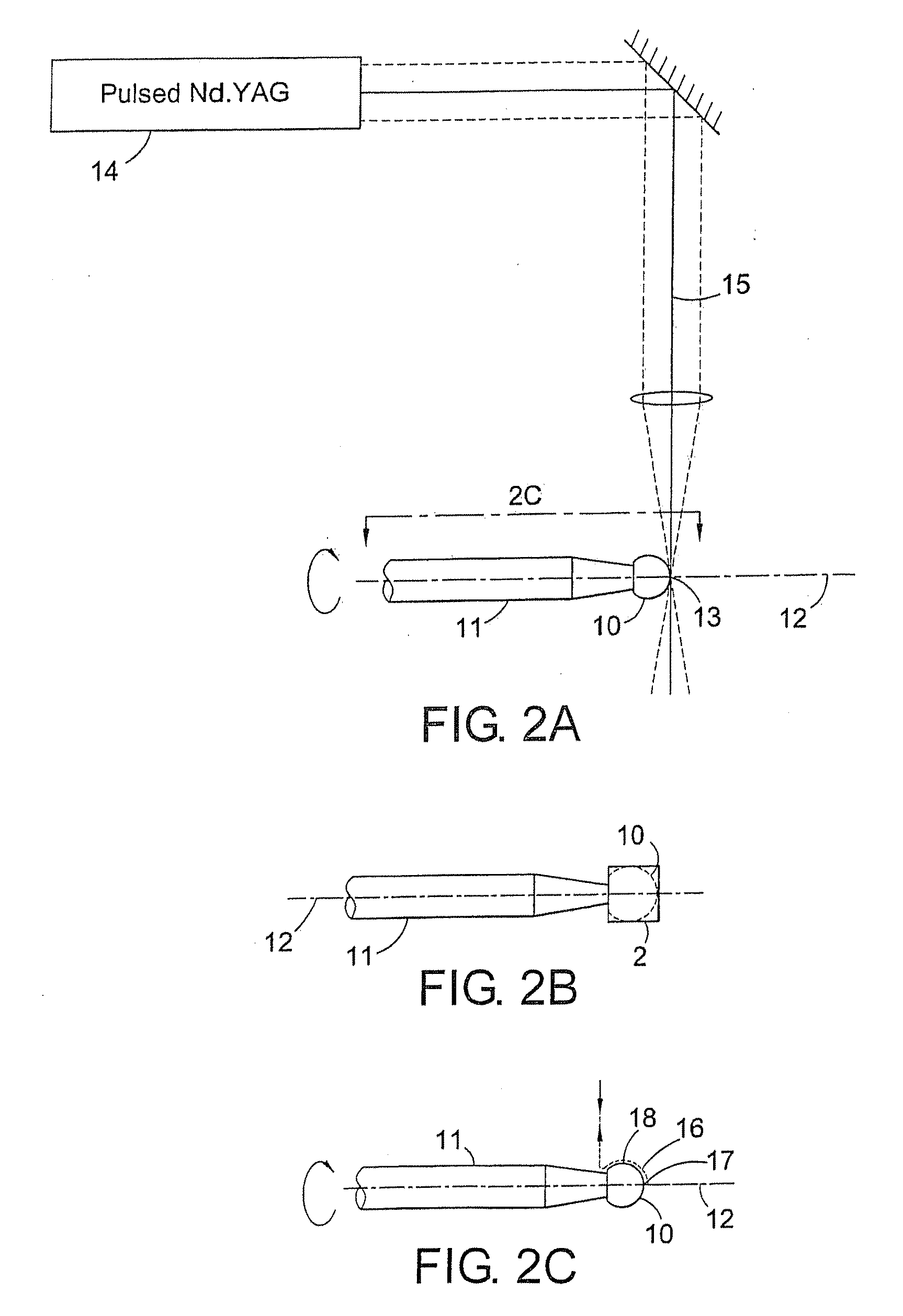Polycrystalline diamond elements having convex surfaces
- Summary
- Abstract
- Description
- Claims
- Application Information
AI Technical Summary
Benefits of technology
Problems solved by technology
Method used
Image
Examples
example 1
Super-Hemispherical Synthetic CVD-Grown Single-Crystal Diamond SIL with 8-Sided Pavilions
[0138]A super-hemispherical solid immersion lens (SIL) was made from CVD-grown synthetic single-crystal diamond. A CVD grown diamond, approximately 4.5×4.5×3 mm in size, was first sawn into plates of approx. 1.2 mm thick. One plate was then polished flat on one side and mounted onto a graphite carrier plate and placed on an XY translation stage in the focus of a pulsed Nd:YAG cutting laser. Pulse energy was 1.2 mJ in a 150 ns pulse with a pulse repetition rate of 4000 pps (pulses per second). The XY-stage then executed a circular motion with diameter 1.3 mm so that a cylindrical disc was cut out of the plate with diameter 1.3 mm.
[0139]Subsequently the disc was cleaned to remove any laser residue and brazed with the polished side onto a molybdenum rod which was 20 mm long and 3 min in diameter with a eutectic alloy of gold and tantalum. The axis had a tapered end such that at the tip where the di...
example 2
Hemispherical Synthetic CVD-Grown Single-Crystal Diamond SIL
[0145]A hemispherical SIL was made from CVD-grown synthetic single-crystal diamond. A CVD grown diamond, approximately 3×3×2.8 mm in size, was first sawn into plates of approx. 0.8 mm thick. One plate was then polished on one side and mounted onto a graphite carrier plate and placed on an XY translation stage in the focus of a pulsed. Nd:YAG cutting laser. Pulse energy was 1.2 mJ in a 150 ns pulse with a pulse repetition rate of 4,000 pps. The XY-stage then executed a circular motion with diameter 1.4 mm so that a cylindrical disc was cut out of the plate with diameter 1.4 mm.
[0146]Subsequently the disc was cleaned to remove any laser residue and brazed on the polished side onto a molybdenum rod which was 30 mm long and 3 mm in diameter with a eutectic alloy of gold and tantalum. The rod had a tapered end such that at the tip where the diamond was soldered its diameter was 0.8 mm. Prior to brazing the diamond disc was place...
example 3
Biconvex Natural IIa Type Single-Crystal Diamond Lens of which One Surface has a Hemispherical Shape
[0151]A hemispherical diamond surface was made from natural type IIa single-crystal diamond. A type IIa diamond, approximately 4 ct in size, was first sawn into plates of approx. 0.95 mm thick. One plate was then polished on one side and mounted onto a graphite carrier plate and placed on an XY translation stage in the focus of a pulsed Nd:YAG cutting laser. Pulse energy was 1.2 mJ in a 150 us pulse with a pulse repetition rate of 4,000 pps. The XY-stage then executed a circular motion with diameter 1.6 mm so that a cylindrical disc was cut out of the plate with diameter 1.6 mm.
[0152]Subsequently the disc was cleaned to remove any laser residue and brazed with the polished side onto a molybdenum rod which was 30 mm long and 3 mm in diameter with a eutectic alloy of gold and tantalum. The rod had a tapered end such that at the tip where the diamond was soldered its diameter was 1.2 mm....
PUM
| Property | Measurement | Unit |
|---|---|---|
| Length | aaaaa | aaaaa |
| Angle | aaaaa | aaaaa |
| Radius | aaaaa | aaaaa |
Abstract
Description
Claims
Application Information
 Login to View More
Login to View More - R&D
- Intellectual Property
- Life Sciences
- Materials
- Tech Scout
- Unparalleled Data Quality
- Higher Quality Content
- 60% Fewer Hallucinations
Browse by: Latest US Patents, China's latest patents, Technical Efficacy Thesaurus, Application Domain, Technology Topic, Popular Technical Reports.
© 2025 PatSnap. All rights reserved.Legal|Privacy policy|Modern Slavery Act Transparency Statement|Sitemap|About US| Contact US: help@patsnap.com



